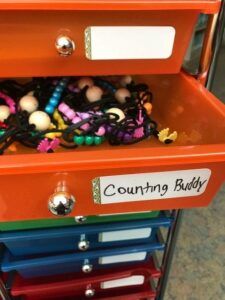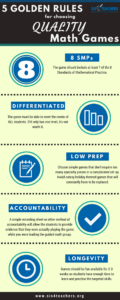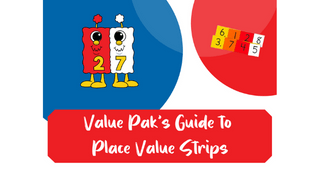Here’s part 2 of our mini binder project – the fun parts: manipulatives and games!
This resource was definitely a labor of love, but we realized that if we were writing a curriculum that we want teachers to really use, we felt like we needed to set them up for the best success possible.
Read Part 1 (standards, number talks, and model drawings) here!
Missed an episode? See the whole Instruction by Design Series here.
CPA (Concrete-Pictorial-Abstract)
 Manipulatives are a very important part of quality math instruction so that kids understand the standards being taught in the unit. In the past, I’ve made lists for teachers of the different tools they’ll need to teach various concepts (place value disks, Cuisenaire® Rods, etc.) but sometimes, with everything going on, you might have the tools pulled out and no idea how to use them in your current unit! If you’re new to the grade level or subject area, you might not even know what a Cuisenaire® Rod or a rekenrek is!
Manipulatives are a very important part of quality math instruction so that kids understand the standards being taught in the unit. In the past, I’ve made lists for teachers of the different tools they’ll need to teach various concepts (place value disks, Cuisenaire® Rods, etc.) but sometimes, with everything going on, you might have the tools pulled out and no idea how to use them in your current unit! If you’re new to the grade level or subject area, you might not even know what a Cuisenaire® Rod or a rekenrek is!
To make this section more user-friendly and a resource that could be used by teachers that are new to a grade, we included pictures of the tools that should be included in the Math Salad Bar for that unit. Additionally, in the lessons (more on that later!), we also included additional suggestions for what CPA tools might support that concept. For example, the book might recommend using place value base-10 blocks, but we would also add place value discs and strips and a place value mat. For some of the tools, we included “out of the box” uses, for example how to use an abacus for quantities other than 1-100 (fractions, decimals. etc.).
 It’s been so fun to watch the idea of the Math Salad Bar take off in a lot of our schools. It’s a simple concept – ten drawers on one side, five on the other, dry erase labels on each drawer so students know what’s in them, and plastic “salad bowls” on top. Typically in a classroom, math manipulatives are stored in a secured location, only to be accessed by teachers,but, as we attempt to develop more independence in our students, the Math Salad Bar is open during math time and is a place students can go to get the manipulatives they need to support the development or reinforcement of a particular skill.
It’s been so fun to watch the idea of the Math Salad Bar take off in a lot of our schools. It’s a simple concept – ten drawers on one side, five on the other, dry erase labels on each drawer so students know what’s in them, and plastic “salad bowls” on top. Typically in a classroom, math manipulatives are stored in a secured location, only to be accessed by teachers,but, as we attempt to develop more independence in our students, the Math Salad Bar is open during math time and is a place students can go to get the manipulatives they need to support the development or reinforcement of a particular skill.

The teacher might model the use of the manipulative quickly on the document camera but we want to move towards letting kids have that valuable time to explore math ideas on their own with the supporting resources. To facilitate that, we wanted teachers to be able to, at a glance, know exactly what to include in their Math Salad Bar. There are some things in the Salad Bar, like dice and clear counters that might be there all year because they are used for games, but we wanted this section of the binder to be very clear about what materials should be ready for the students so teachers don’t have to spend a great deal of time organizing the manipulatives.
Games

For each unit, we selected between two and six standards-based application games that would be available on the Math Salad Bar for kids to play during the Math with Someone station. We didn’t want games that would just keep them busy, we want students to get their hands on the materials and explore with other people collaboratively in a group setting. Some math programs already provide great application games, but sometimes those games tend to require a lot of prep. By the time you’re done laminating and cutting, the unit might already be over! And, typically, the pieces don’t live to see another year because they get lost or destroyed.
There are five criteria we use when selecting quality math games. Here are Shannon’s Golden Rules for Quality Math Games (read more here):
 A quality math game should include:
A quality math game should include:
- 7 of the 8 Mathematical Practices.
- Easy differentiation options. The game should be adjustable for ALL learners.
- Low preparation. The game should require minimal pieces/copies/hours to set up.
- Accountability. Students should be able to demonstrate their learning.
- Longevity. Students should be able to play it for 2-3 weeks for maximum impact on learning.
We gathered games from many different places. Of course, for many of the units involving numeracy, we used our Deck o’ Dots Games with various levels of differentiation, which you can learn about by watching the video tutorials. K-5 Math Teaching Resources was another invaluable resource as their games are listed by standard, which makes it really easy to come up with standards-based games for kids to play. They are simple to play and simple to prep with minimal colors and pieces! We also used Embarc.online, which is based on the Eureka Math program and is organized by grade level, and then unit.
For each game in the mini binder, we included a picture of the student game board and all the materials required the game, so at a glance teachers can have all the information they need. Some teachers took this section of the mini binder out and put it into its own binder on the Math Salad Bar so students would be able to use this special “Math Games” mini binder to gather required manipulatives independently during Math with Someone.

To go along with this section of the mini binder, we did something that I’ve always wanted to do; we created a Master Game Binder! This 4” binder is packed with clear sleeves that contain game boards, accountability sheets, directions, and whatever else you might need for all the games. For each game, we included three “nice” copies of the game where we granted whatever copy wishes teachers had for those materials (printed in color, on cardstock, double-sided, etc.). It’s not that we think teachers can’t do this on their own, they certainly can. But when there are new curriculums in almost every single subject, teachers are simply overwhelmed and collecting everything they need in one place saves a ton of time!
Why three copies? Well, some of the games were designed for two players, some are for four players, but if you had three copies of a two-person game in your binder, you could have at least six kids playing at a time. With three rotations of 8-10 kids, you’d only have to make one or two copies so that all the kids could play at a time. Or, in order to accommodate all 8-10 kids, you can have multiple games open for use, for example, Multiplication Bump, Multiplication Four in a Row, and the Array Game. Kids will learn that, if all the game boards are taken, they can just play a different game.

Additionally, we created three 1” individual game binders intended for student use. We wanted teachers to be able to take those three copies and put one in each smaller binder so that all the game boards for the whole unit are housed in one place on the Math Salad Bar. At the end of the unit, once the games have been played, you would open all three binders, pull those games out and put them all back into the master binder, flip to Unit 2 in your master binder, and reset the student binders.
This works really well for grades 2-5. For 1st grade, the success of this system depends on the temperament of your class. For our Kinder kid, this binder system might be a bit more difficult at the beginning of the school year while they’re learning routines and transitions, so setting out bins and centers might work a bit better for them.
Our teachers were super excited about this, especially if they didn’t already have games that were standards-aligned that went with their units. We’ve all been there: we have all these games pinned or bookmarked to use, spending thousands of dollars on stuff that we intended to tie into the curriculum somehow and never got around to. It was a relief for our teachers to know that they had everything ready to go, but we did encourage teachers to make their binders their own. If they already had a multiplication battleship game that they really really liked, they added it to the binder along with any necessary materials to play it.
We picked out games that would give us the most bang for our buck – games that students could play over the course of several units, that they enjoyed and that weren’t too complicated so they could learn to play quickly.



